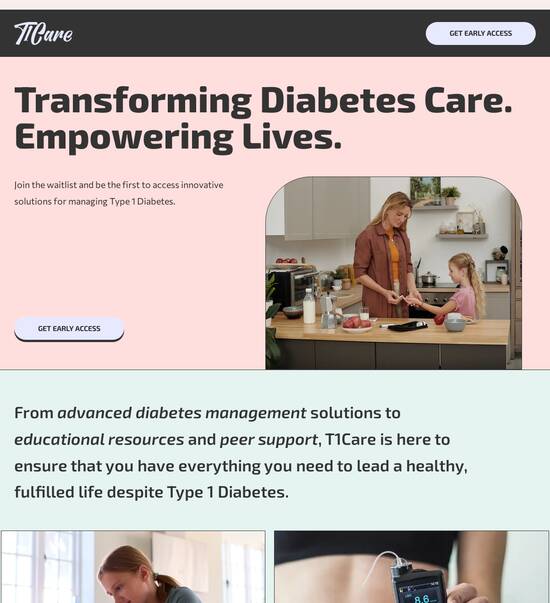
JQuery optimized feedback page template
Explore Similar TemplatesAbout template
Supercharge your feedback page with jQuery for outstanding performance! Learn more today.
Recommended templates

Easy to build without coding
With the intuitive drag-and-drop builder, anyone on your team can create high-converting pages without any knowledge of code or design. Make enhancements to your landing page with custom widgets using Javascript, HTML/CSS, or third-party scripts.

Multiple layouts for any industry and goal
Select from 500+ landing page layouts built to boost conversions across industry-specific scenarios. Customize them by adjusting fonts, adding images, and generating on-brand content with the AI assistant. Quickly scale with Instablocks® and Global Blocks that you can save, reuse, and update globally.

Loads fast and looks polished on any device
Every template is responsive, which means they present professionally on any device and load blazingly fast with our Thor Render Engine. You can also power them up with Google AMP technology to deliver an unparalleled mobile experience and drive higher conversions.

Robust analytics & experimentation
Get real-time updates and reporting across all your devices, showing the number of visitors, conversions, cost-per-visitor, and cost-per-lead. Launch AI-powered experiments, run A/B tests, and use heatmaps to analyze user behavior, then optimize your landing page to maximize conversions.







Easy to build without coding
With the intuitive drag-and-drop builder, anyone on your team can create high-converting pages without any knowledge of code or design. Make enhancements to your landing page with custom widgets using Javascript, HTML/CSS, or third-party scripts.
Multiple layouts for any industry and goal
Select from 500+ landing page layouts built to boost conversions across industry-specific scenarios. Customize them by adjusting fonts, adding images, and generating on-brand content with the AI assistant. Quickly scale with Instablocks® and Global Blocks that you can save, reuse, and update globally.
Loads fast and looks polished on any device
Every template is responsive, which means they present professionally on any device and load blazingly fast with our Thor Render Engine.
Robust analytics & experimentation
Get real-time updates and reporting across all your devices, showing the number of visitors, conversions, cost-per-visitor, and cost-per-lead. Launch AI-powered experiments, run A/B tests, and use heatmaps to analyze user behavior, then optimize your landing page to maximize conversions.
All the features you need to build lead-generating landing pages
Explore more featuresLearn how to build top-performing landing pages for any goal
FAQs
Leading the way in building high-performing landing pages





A comprehensive guide to using Instapage for optimizing your landing pages
Instapage stands out as an exceptional landing page and conversion rate optimization (CRO) platform, perfectly suited for marketers looking to enhance their digital campaigns. By integrating various tools for page creation and audience personalization, Instapage simplifies the process of converting leads effectively. This guide will walk you through the key aspects of leveraging Instapage's capabilities to transform your marketing strategies, no matter your budget or team size.
Understanding the importance of landing pages
Landing pages are critical in driving conversions and maximizing ROI for your digital marketing efforts. They serve as dedicated websites tailored to specific promotional campaigns, allowing you to target visitor interests and turn them into potential leads. With Instapage, creating effective landing pages becomes a streamlined process, enabling you to harness the following benefits:
- High-converting templates: Access over 100 templates specifically designed to improve conversion rates, ensuring your landing pages look professional and are effective.
- Built-in analytics: Use detailed performance insights provided by Instapage to understand on-page behavior and iterate on your strategies.
- Integration capabilities: Instapage allows seamless integration with various marketing tools for a more cohesive campaign execution.
Step 1: Creating your landing page
Building a landing page with Instapage is both intuitive and flexible. Here’s how you can get started:
Quick setup using templates
Begin by selecting a template from Instapage's vast library. Each template is designed with conversion in mind. You can easily customize it to align with your brand's aesthetics.
- Choose a targeted template based on your campaign goals, be it lead generation or product promotion.
- Utilize the drag-and-drop builder to make adjustments without needing any coding skills.
- Incorporate lead generation elements such as forms, buttons, and images directly onto the page.
Step 2: Optimization for conversions
Once your page is set up, the next step is optimizing it to ensure maximum effectiveness:
- Implement A/B testing to see which elements perform best in terms of conversion rates.
- Utilize heatmaps to understand user behavior and adjust layout or content accordingly.
- Incorporate personalized messaging for various audience segments using dynamic text replacement.
In conclusion, leveraging Instapage not only enhances your landing page strategy but also significantly boosts your overall marketing campaigns.
Take action today to create landing pages that convert! Start using Instapage and watch your marketing ROI soar.
jQuery optimized feedback page template: enhancing user engagement and experience
Understanding the importance of feedback pages in digital platforms
Feedback pages serve as crucial touchpoints between users and service providers, allowing for meaningful exchanges that can enhance product development and user satisfaction. The role of feedback cannot be understated: it directly impacts user engagement and overall user experience, making it imperative for digital platforms to incorporate effective feedback mechanisms.
When users have the opportunity to share their thoughts and opinions, it not only creates a sense of community but also empowers them to feel valued and heard. User-centric design principles further emphasize the importance of integrating feedback into the whole process, ensuring that digital platforms remain responsive to user needs.
Enhancing user experience through feedback
Importance of user-centric design
Common issues with feedback collection
Despite the apparent benefits, many digital platforms face significant hurdles in effectively collecting feedback. One challenge is the ineffective communication channels that may lead to users feeling frustrated. If there is no clear or straightforward way through which users can voice their opinions, they may disengage entirely from the platform.
Moreover, a lack of user-friendly interfaces can severely hinder feedback collection efforts. If the feedback submission process is convoluted or unintuitive, users are less likely to provide valuable insights. Therefore, overcoming these challenges is vital for enhancing engagement and ensuring a consistent flow of user feedback.
Ineffective communication channels
Lack of user-friendly interfaces
Unveiling the jQuery optimized feedback page template
To address the challenges associated with feedback collection, the jQuery optimized feedback page template presents a compelling solution. But what makes a feedback page template stand out? The incorporation of jQuery leads to dynamic interactions, creating a more engaging user experience. This allows users to navigate through various sections smoothly while submitting their feedback with ease.
Key features that enhance the feedback template include responsive design, real-time validation for user inputs, and a visually appealing layout that draws users in. The jQuery optimized template stands out not just for its functionality but also for its aesthetic appeal.
Integration of jQuery for dynamic interactions
Key features of the optimized template
Essential technologies underpinning the template
The success of the jQuery optimized feedback page template is supported by essential technologies. For instance, compatibility with various frontend frameworks ensures seamless integration with existing web applications. Whether it is React, Angular, or Vue.js, the template can work harmoniously within a developer's preferred environment.
Furthermore, backend support for data gathering enhances the template's efficacy. By employing robust database solutions, developers can effectively capture and analyze feedback data, turning user insights into actionable improvements.
Frontend framework compatibility
Backend support for data gathering
Key features of the jQuery optimized feedback page template
When discussing features pivotal to the jQuery optimized feedback page template, a user-friendly interface design is paramount. A well-structured menu bar allows for easy navigation, guiding users to various sections of the feedback page effortlessly. This intuitive design ultimately reduces the friction users might experience when trying to submit their thoughts.
Location accessibility is also an important aspect; the template can be optimized for users across various devices, including mobile phones. As mobile browsing continues to gain traction, a responsive design ensures that feedback can be submitted anytime and anywhere, widening the pool of potential respondents.
The role of the menu bar for navigation
Widespread location accessibility for diverse users
Real-time interaction through Q&A elements
One of the standout features of the jQuery optimized feedback page template is the inclusion of real-time Q&A elements. These sections encourage community engagement and allow users to interact with one another by asking questions and providing answers. This creates a vibrant space for collaborative knowledge sharing, fostering a sense of community around your platform.
Implementing interactive questions can be done through simple jQuery scripts that trigger responses based on user actions. Such interactivity not only captures insights directly but also keeps users engaged, as they become an integral part of the discussion.
How Q&A sections foster community engagement
Techniques for implementing interactive questions
Versatile content collection options
Versatility in feedback collection is another focal point of the jQuery optimized feedback page template. The template allows for a combination of predefined answers and open-ended questions, catering to varying user preferences and encouraging a diverse range of feedback.
By strategically designing the options, you can steer users toward providing tailored responses. This can significantly enrich the data collected, as open-ended questions can unearth insights that predefined options may overlook, leading to a more comprehensive understanding of user needs.
Predefined answers vs. open-ended questions
Strategies for tailored responses
Technical insights: building with the jQuery optimized template
Building with the jQuery optimized feedback page template requires a focus on key elements in the code structure to achieve optimal performance. Firstly, implementing jQuery enables enhanced interactivity, ensuring a responsive experience for users. Simple animations and dynamic elements can guide users through their feedback journey, making instructions more engaging.
Additionally, modular code design is essential for easy customization. Developers can implement various features independently, allowing for quicker iterations and updates based on user feedback or evolving design trends.
Implementing jQuery for enhanced interactivity
Modular code design for easy customization
Technologies leveraged for performance optimization
Performance optimization is a crucial aspect of the jQuery optimized feedback page template. Leveraging AJAX for seamless data submission enhances user experience by removing the need for full page reloads after feedback is provided, allowing for a smoother transition back into the feedback interface.
Moreover, using CSS efficiently for responsive design ensures that users on all devices have a consistent and pleasant experience. Clean, well-structured CSS can help maintain aesthetic quality while reducing load times, ultimately making online feedback collection more efficient.
Leveraging AJAX for seamless data submission
Utilizing CSS for responsive design
Enhancing team collaboration with feedback mechanisms
With efficient feedback mechanisms in place, teams can leverage the insights gathered for continuous improvement. Collaborative platforms can aid in sharing insights derived from user feedback, allowing team members to align their strategies based on real user experiences. This holistic approach fosters an environment where everyone contributes to refining the offer.
Implementing effective algorithms for analyzing community feedback is another pivotal aspect. By categorizing, prioritizing, and analyzing feedback, teams can make data-driven decisions that directly boost user satisfaction and platform performance.
Collaborative platforms for sharing insights
Effective algorithms for analyzing community feedback
Newer technologies and their impact on team workflows
Integration with existing project management tools can significantly streamline teamwork. By incorporating feedback mechanisms directly into these tools, teams can track user insights in real-time, ensuring that feedback is not just a checkbox exercise but a vital component of the development process.
Additionally, creating multiple access points for teams to aggregate feedback efficiently will enhance responsiveness. This ensures that every team member can easily navigate to relevant insights, making collaboration more effective and actionable.
Integration with existing project management tools
Access points for teams to aggregate feedback efficiently
The role of community and collective knowledge in feedback collection
Creating a knowledge base from user responses is instrumental. Curating valuable content helps in distilling significant insights that can improve products over time. By establishing feedback loops, digital platforms can address user concerns, thus elevating overall user satisfaction and trust.
Moreover, establishing communities for mutual learning enhances the feedback process. Interactive features that allow users to connect and share their experiences not only enrich the feedback collected but also fortify user loyalty. Users are more likely to engage if they perceive their involvement as part of a larger collective initiative.
The process of curating valuable content
Using feedback loops to improve user satisfaction
The role of collectives in shaping feedback pages
Collectively driven enhancements to feedback pages can lead to innovative features that users appreciate. Collaborations with user groups establish a feedback-driven setting, allowing for the design and evolution of key functionalities based on real user input.
Equally important, special features that promote interaction among users create a rich dialogue surrounding feedback. These interactions can include comment sections or real-time discussion boards that enlist community contributions to the ongoing development of the feedback mechanism itself.
Establishing communities for mutual learning
Special features that promote interaction among users
Engaging users: the experience journey on feedback pages
Creating engaging previews that capture user attention is essential for effective feedback collection. Implementing best practices for visual design can make feedback pages attractive and maintain user interest throughout the process. Thoughtful layout choices ensure that users are not overwhelmed, allowing for a seamless experience.
Additionally, employing data visualization techniques to present feedback can greatly enhance user understanding and retention. Clear, engaging visuals can showcase trends from responses, conveying information without overwhelming users with raw data.
Best practices for visual feedback page design
Data visualization techniques to present feedback
Crafting a seamless user experience
Ultimately, designing a seamless user experience is about ensuring the flow of information from feedback answers to final outputs is intuitive. Clear transitions and unobtrusive design elements guide users naturally through the process, resulting in higher completion rates for feedback submissions.
Moreover, accessibility must be prioritized for all users, including those with special needs. Implementing features that accommodate varying levels of accessibility not only fulfills compliance but also ensures that all user voices can be heard.
The flow of information from answers to final outputs
Ensuring accessibility for all users, including special needs
Measuring success: analytics and key metrics for feedback pages
Identifying key performance indicators (KPIs) is essential for measuring the success of feedback pages. Metrics such as the rate of feedback conversion and user engagement statistics reveal how well users are interacting with the feedback mechanisms provided by a platform.
These KPIs inform teams about the effectiveness of their feedback strategies, allowing for targeted improvements. Tracking data over time also helps understand trends and how user behavior evolves, providing valuable insights for future design iterations.
Rate of feedback conversion
User engagement statistics
Tools and technologies for performance measurement
Integrating analytical tools with the jQuery optimized feedback page template simplifies performance measurement. Using advanced analytics technologies allows teams to collect and analyze data efficiently, turning insights into actionable strategies.
These tools can be customized to create reports that cater to specific user segments, ensuring that every applicable piece of feedback can be addressed effectively.
Analytical tools integrated with the template
Collecting and analyzing data efficiently
Future directions: innovations in feedback page design
As technology evolves, so do the methods for user feedback collection. Emerging trends such as artificial intelligence and machine learning applications offer new dimensions in understanding user responses. Utilizing these technologies can enable platforms to process feedback at unprecedented speeds, offering quicker analytics and targeted improvements.
Moreover, the shift toward mobile-first feedback solutions cannot be overlooked. Developing templates that prioritize mobile compatibility and responsiveness will become increasingly vital in ensuring a seamless experience for all users, particularly in a world where mobile browsing is predominant.
AI and machine learning applications
The shift towards mobile-first feedback solutions
Community-driven enhancements to feedback pages
Community-driven enhancements can significantly influence feedback page evolution. Communities that form around products are valuable sources of real-time insights, enabling iterative cycles of feedback collection and implementation. Continuously incorporating community suggestions helps transform feedback platforms into user-centric solutions.
Furthermore, collaborating with user groups not only fosters innovation but also strengthens user loyalty. When users see their feedback being recognized and implemented, they are more likely to advocate for the product, enhancing brand trust and building a positive reputation.
Collaborations with user groups
Iterative feedback collection for continuous improvement
Practical considerations for implementing feedback pages
Implementing feedback pages can be laden with challenges that require careful consideration. One common issue is overcoming technical barriers, which often arise during the deployment of new systems. Thorough planning and utilizing the capabilities of the jQuery optimized feedback page template can help mitigate these challenges.
Additionally, ensuring user buy-in and engagement is critical. Communicating the value and impact of user feedback can motivate users to participate actively, making them more likely to provide valuable insights.
Overcoming technical barriers
Ensuring user buy-in and engagement
Best practices for maintaining effective feedback loops
Maintaining effective feedback loops involves regular updates based on user input. Consistently acting on user feedback demonstrates commitment to user-centric design, which in turn, enhances trust and loyalty.
Moreover, fostering an open and responsive feedback culture creates an environment where users feel comfortable sharing their thoughts, knowing that their contributions will lead to meaningful changes.
Regular updates based on user input
Fostering an open and responsive feedback culture
Conclusion: the transformative power of feedback pages using jQuery
Summarizing the advantages of utilizing an optimized template, it is clear that a jQuery optimized feedback page can significantly enhance user experiences and engagement. By leveraging jQuery's capabilities, teams can gather genuine insights and feedback while allowing for unobtrusive user interactions.
Encouraging continuous evolution through feedback integration can establish a culture of receptiveness. As platforms iterate based on user suggestions, they will position themselves as leaders in user experience, building lasting relationships and maintaining customer loyalty.
Ready to skyrocket conversions?
Supercharge your ad campaigns with high-performing landing pages
Get started














